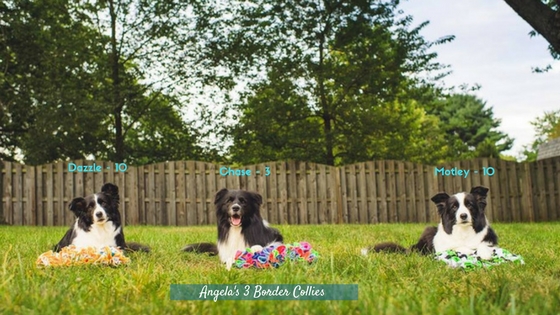
All dogs no matter age, breed, or size have a natural desire to engage in enriching mental and physical activities. However, for senior dogs, physical activity may eventually become limited due to arthritis or medical issues that prohibit your dog from taking long walks or romping around in the yard. When that happens, mental stimulation becomes even more important. A dog who feels satisfied is one who is less likely to exhibit destructive or disruptive behaviors, or worse, develop problematic emotional issues associated with a lack of satisfaction (e.g. depression, frustration, decreased ability to cope with stress, etc.).
Types of Enrichment
Dogs are scavenging predators, which means that the activities they find most satisfying will usually revolve around behaviors associated with obtaining food. This can be broken down into two categories: predatory 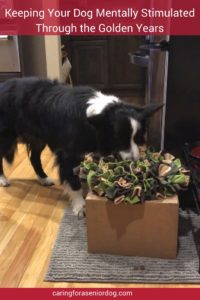 activities and scavenging activities.
activities and scavenging activities.
For sake of time, we’ll focus on scavenging activities, which can be defined as any behavior (other than predatory behavior) that a dog employs to obtain food. Training new behaviors and tricks could fall into this category (e.g. a dog solves a problem and receives a piece of food from his/her trainer/handler), but the usual suspects include Kongs, treat dispensers, nose work games, puzzle toys, snuffle mats, etc.
Wait. A what mat?
Snuffle mats are an interactive work-to-eat dog “toy” that provide entertainment, enrichment, and mental stimulation for dogs as they search, sniff, and snuffle their way to find the hidden treats you place in advance. They’re a great way to help dogs relieve boredom and a must-have addition to anyone’s box of work-to-eat toys.
My husband is a dog trainer/behavior consultant and has introduced snuffle mats to hundreds of dogs over the past year and noticed two universally common things among almost every dog that’s engaged with one. First, they all seem to be interested in it. Personally, I’ve seen dogs indifferent to treat balls and Kongs, but have yet to see one of my husband’s client’s dogs not be intrigued and then enthralled by a snuffle mat loaded with the appropriately motivating food/treats. Second, the level of satisfaction seems to be high for almost every dog who works on it (measured visually by observing the obvious arousal levels of a dog before and after working on one). They LOVE it!
Snuffle Mat Uses and Benefits
There are tons of different use cases for snuffle mats, and a few good ones directed at improving the lives of senior dogs.
For those dogs who aren’t as mobile, or have trouble bending down to eat food off the ground, you can prop the snuffle mat on top of a box or small table to relieve any strain on your dog’s neck/shoulders. Pepper demonstrates here:
Also, unlike most work-to-eat toys, a snuffle mat will more likely “stay put” versus rolling away. It’s a great solution, especially for blind dogs who find themselves bumping into things or getting frustrated when they have trouble keeping up with a toy that moves around too much. Owner frustration may also set in if you’re having to constantly fetch a Kong or treat ball that rolled under your couch to give it back to your dog.
Chap is a blind, senior border collie being fostered by a wonderful woman who was looking for a toy that would keep his brain working and that he’d enjoy since other work-to-eat type toys would easily roll away, making it hard for him to find or make him bump into things in the process. A snuffle mat was the perfect solution – the mat stays put, and Chap can dig in to find his treats without worrying about it rolling away. See Chap in action.
A snuffle mat is also great for dogs recovering from an illness or surgery and restricted from exercise or physical activity as it makes it easier for your dog to stay in a smaller area, while still exerting mental energy. Dr. Elizabeth 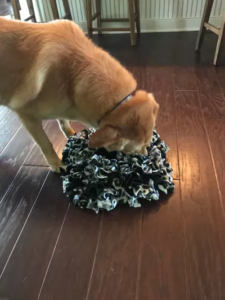 Williams, DVM, CVA, CCRT of Whole Health Mobile Pet Care (Triangle Township, NC) recommends snuffle mats to her patients to include in their rehab exercises and says, “it’s a great way to encourage strength training and weight shifting while they are healing.”
Williams, DVM, CVA, CCRT of Whole Health Mobile Pet Care (Triangle Township, NC) recommends snuffle mats to her patients to include in their rehab exercises and says, “it’s a great way to encourage strength training and weight shifting while they are healing.”
One of the biggest issues with senior dogs is the loss of core muscle mass associated with a diminishing of activity. The mat is a great tool for low-impact exercise.
Other use cases include:
- Slowing down speedy eaters
- Enticing a dog who is not very enthusiastic about eating or hesitates when eating out of traditional plastic or metal bowls.
- Helps with behavior modification: slowly introduce your dog to new sites, smells, and noises by allowing them to use the snuffle mat while anxiety-causing stimulus is nearby.
- Some dogs are a bit anxious or apprehensive when new guests come into the home: move your dog to a gated off area with the snuffle mat to help redirect that anxiety until they are more settled.
- For dogs with separation anxiety or distress: sometimes other interactive work-to-eat toys are too passive to engage a dog’s brain. Research shows the opposite for dogs who use a snuffle mat – 7 out of 10 dogs showed significant improvement in their mental and physical well-being when a bowl or plate of snacks was replaced with a long fiber carpet (like a snuffle mat).
- Use it while you’re making or eating dinner to keep your dog out of the kitchen.
- Inclement weather makes it harder to provide dogs with physical activity – use a snuffle mat to help expend mental energy instead.
- Helps acclimate your dog to the car and car rides.
- Makes crate time a fun time.
Not All Snuffle Mats are Created Equal
As with any product on the market today, the materials used to create it play a critical role in how well the product works and lasts. My company, SnuffleMutt, only uses anti-pill fleece, and while it’s more expensive, the benefits outweigh those of inferior, cheaper snuffle mats using less expensive and lesser quality fleece. For example, over 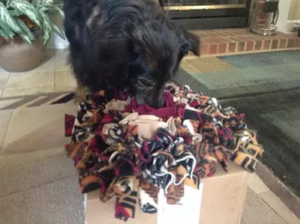 time, small pill and lint balls will not form on the edges of the fabric (and end up in your dog’s stomach), which is what happens with cheaper, less expensive fleece. Additionally, the heavier the fleece, the longer the snuffle mat will last. The base of the mat is a thick rubber, so the mat is also less likely to be easily moved around versus rolling around like its treat ball counterpart.
time, small pill and lint balls will not form on the edges of the fabric (and end up in your dog’s stomach), which is what happens with cheaper, less expensive fleece. Additionally, the heavier the fleece, the longer the snuffle mat will last. The base of the mat is a thick rubber, so the mat is also less likely to be easily moved around versus rolling around like its treat ball counterpart.
The fleece is also a higher density, which means the fleece strips won’t easily flatten or become limp like other mats that use inferior fabrics. Better fleece means the curls keep their shape, providing a bigger surface area (i.e. more curls in which to hide food). This also means your dog must snuffle down even further to find his or her treats. More snuffle time will keep your dog busy for longer durations.
It’s also super easy to care for. Since I recommend using harder-type treats (e.g. kibble, broken up biscuits, training treats, etc.), the mat likely will not need to be washed frequently. However, as needed, it can be thrown in the wash (no bleach!) and dried in the dryer on low heat.
At the end of the day, whether you have a new puppy or senior dog, the end game is the same: a satisfied, less-stressed dog, equals a happier dog that can more easily settle and relax. I think it’s safe to say we all want that for our furry family members ????
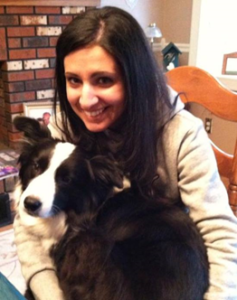 Angela Tuzzo is a technology PR specialist by day and owner/creator of SnuffleMutt snuffle mats by night. She is also “mom” to three border collies: Motley and Dazzle (age 10) and Chase (age 3). She can be reached through her website www.snufflemutt.com
Angela Tuzzo is a technology PR specialist by day and owner/creator of SnuffleMutt snuffle mats by night. She is also “mom” to three border collies: Motley and Dazzle (age 10) and Chase (age 3). She can be reached through her website www.snufflemutt.com

 End of Life Care – A Veterinarian’s Perspective
End of Life Care – A Veterinarian’s Perspective
Leave a Reply